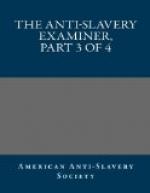We have said that slaveholders regard their slaves not as human beings, but as mere working animals, or merchandise. The whole vocabulary of slaveholders, their laws, their usages, and their entire treatment of their slaves fully establish this. The same terms are applied to slaves that are given to cattle. They are called “stock.” So when the children of slaves are spoken of prospectively, they are called their “increase;” the same term that is applied to flocks and herds. So the female slaves that are mothers, are called “breeders” till past child bearing; and often the same terms are applied to the different sexes that are applied to the males and females among cattle. Those who compel the labor of slaves and cattle have the same appellation, “drivers:” the names which they call them are the same and similar to those given to their horses and oxen. The laws of slave states make them property, equally with goats and swine; they are levied upon for debt in the same way; they are included in the same advertisements of public sales with cattle, swine, and asses; when moved from one part of the country to another, they are herded in droves like cattle, and like them urged on by drivers; their labor is compelled in the same way. They are bought and sold, and separated like cattle: when exposed for sale, their good qualities are described as jockies show off the good points of their horses; their strength, activity, skill, power of endurance, &c. are lauded,—and those who bid upon them examine their persons, just as purchasers inspect horses and oxen; they open their mouths to see if their teeth are sound; strip their backs to see if they are badly scarred, and handle their limbs and muscles to see if they are firmly knit. Like horses, they are warranted to be “sound,” or to be returned to the owner if “unsound.” A father gives his son a horse and a slave; by his will he distributes among them his race-horses, hounds, game-cocks, and slaves. We leave the reader to carry out the parallel which we have only begun. Its details would cover many pages.
That slaveholders do not practically regard slaves as human beings is abundantly shown by their own voluntary testimony. In a recent work entitled, “The South vindicated from the Treason and Fanaticism of Northern Abolitionists,” which was written, we are informed, by Colonel Dayton, late member of Congress from South Carolina; the writer, speaking of the awe with which the slaves regard the whites, says,—
“The northerner looks upon a band of negroes as upon so many men, but the planter or southerner views them in a very different light.”
Extract from the speech of Mr. SUMMERS, of Virginia, in the legislature of that state, Jan. 26, 1832. See the Richmond Whig.
“When, in the sublime lessons of Christianity, he (the slaveholder) is taught to ‘do unto others as he would have others do unto him,’ HE NEVER DREAMS THAT THE DEGRADED NEGRO IS WITHIN THE PALE OF THAT HOLY CANON.”




